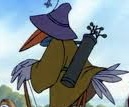I’m reviewing my manuscript and noticing that my scenes tend to trail off towards the end. This has been a long, arduous project and moving from scene to scene where the enthusiasm appeared was one way to keep on track with targets. Now I need to knit everything together into a cohesive whole. What tips to people have for rounding off scenes? How can I best make sure there is continuity between scenes/chapters/segments?
What do you mean by “trail off?”
@CaptainMinnette I mean that writing the decisive action in a scene is not a problem-- working out how that action concludes is what I’m struggling with. Another way to put it is that my scenes are beginning or middle heavy, but don’t have a satisfying end that transitions to the next.
I think there’s generally three ways I end a scene.
The first is to end it on a cliffhanger. This is a classic you see constantly in thrillers with shorter chapters.
With baited breath, the heat of his blood seeming a fire as it streamed down his fingers, he stepped into that place no man had been for centuries.
Though this doesn’t have to be with a character doing something; it could end with something happening to a character of some importance.
Cracks snakes through the ground beneath Akesa’s feet, and she stilled herself, her breath catching in her throat, the roaring thrum of her heart an ever-quickening rhythm pulsing through her ears. For a moment, all was still, quiet save for that pulsing.
Then, with a light popping as her only warning, the precipice gave way all at once.
And she fell.
The second is by going up the pyramid of abstraction again to show something about the character and how the scene has impacted them. Describe what the character is doing as the scene wraps up, even if it’s only going into greater detail on what you had established they were doing throughout the scene, then delve a little into their thoughts. It doesn’t have to be internal monologue; you can just say what the character is thinking or feeling.
Sometimes you can just plop it in the prose and the reader will understand to attribute it to the character; though if you’re doing third person omniscient that’s less true. Showing how a scene made a character feel in ways that may not have been shown in the scene itself is good; if you think you had, you can try and show their thoughts on what they are going to do about it, even if what you put down is vague (which can act as a good hook).
You can even end back on concrete action, combining it with the first example.
The chill wind bit against Reiba’s skin as he stood a moment, squinting his eyes once again. What was that the warlock had said about currents of time? Perhaps her stance of non-interference was valid; it would certainly wouldn’t hurt Reiba to turn back now. He looked to the wound on his wrist, the eldritch venom mingling with his blood to stain it a darker hue as it trickled down his palm.
No. Reiba was past the point of letting others make these decisions for him. Images of the hospice flew through his head, of the young man leaning over him, so certain of the elder Reiba’s demise. He had a new reign on life now, a new body, and he wasn’t going to waste it just sitting in a bottling plant, reading the newspaper and smoking the occasional cigar. It was time for that new life to actually mean something. It was time for action.
You could end that there, or you could follow it up with the first example, ending the chapter with something more concrete than abstract.
The third way is something only to be used a handful of times in a story; usually either at the very beginning or at the end of a major part, but not the end of the story. You end with a character monologue, which oftentimes sets up the next phase of the story. This is classic in a lot of fantasy; sometimes it’s undercut for humor by something happening to the character delivering the monologue. While I made up the previous examples on the spot, I’ll quote now from Dragonsbane, the end of chapter 1.
When he straightened up again, he adjusted the set of his cloak with a kind of sorry hauteur, pushed his bent spectacles a little more firmly up onto the bridge of his nose, and said in a voice that was shaky but oddly determined, “My lord Dragonsbane, I have ridden here on errantry from the south, with a message for you from the King, Uriens of Belmarie.” He seemed to gather strength from these words, settling into the heraldic sonority of his ballad-snatch of golden swords and bright plumes in spite of the smell of the pigsty and the thin, cold rain that had begun to patter down.
“My lord Aversin, I have been sent to bring you south. A dragon has come and laid waste the city of the gnomes in the Deep of Ylferdun; it lairs there now, fifteen miles from the King’s city of Bel. The King begs that you come to slay it ere the whole countryside is destroyed."
The boy drew himself up, having delivered himself of his quest, a look of noble and martyred serenity on his face, very like, Jenny thought, someone out of a ballad himself. Then, like all good messengers in ballads, he collapsed and slid to the soupy mud and cowpies in a dead faint.
These aren’t really hard categories; they blend together and can have aspects of each other. I think that what they have in common is going quickly through the pyramid of abstraction; going from concrete description to abstract thought (which can be expressed in dialogue, too), or vice versa, or going from one to the other then back again.
Edit: I’m realizing now with the terms you use in your original description that you’re writing a screenplay or stage play, or something of the sort. This applies less there as there’s no prose, but can still apply. Sorry for writing something so lengthy, I have only barely started one or two manuscripts of the sort in the past.
Without knowing more of the specifics I can recommend some general tips. It sounds like, from “knit everything together”, you have a bag of scenes that you started because you liked them but didn’t necessarily have how they fit together in mind. That’s ok but it’s a little bit the “we’ll fix it in post” approach - but that’s what editing is for! Just takes longer.
Ok, if that’s the premise I would say my favorite way to tie scenes together is by them ‘rhyming’, Fifth Element does this beautifully. Every transition somehow rhymes with the how the scene before it ended. It’s not a copy however, a character lighting a cigarette at the end of a scene isn’t matched by another lit cigarette but it could be a plume of exhaust from a car, or characters around a fire, or perhaps someone coughing from a punch in the stomach. All you’re doing is rhyming with how the scene before ended. Bonus points if it emphasizes the scene somehow, totally fine if it’s just a transition into something engaging.
And I just reread your comment for what sounds like: editing tips so scenes don’t go on too long. Make them shorter. An apparently misquote attributed to Mark Twain goes “if I had more time, I would have written a shorter letter.” Terrible ‘tip’ I know, but by finding what it is you’re trying to accomplish with a scene and then trimming all the excess it is like refining a jewel so it shines more brightly.
@Revolving_Glass thanks for the suggestion. I’ll bear this in mind as I edit.
Here is great scene structure video from Ellen Brock. Its an excellent video about how to approach and improve your scenes, no matter what youre doing. (Check out her whole channel actually, very solid and straightforward writing advice all around.) :)




